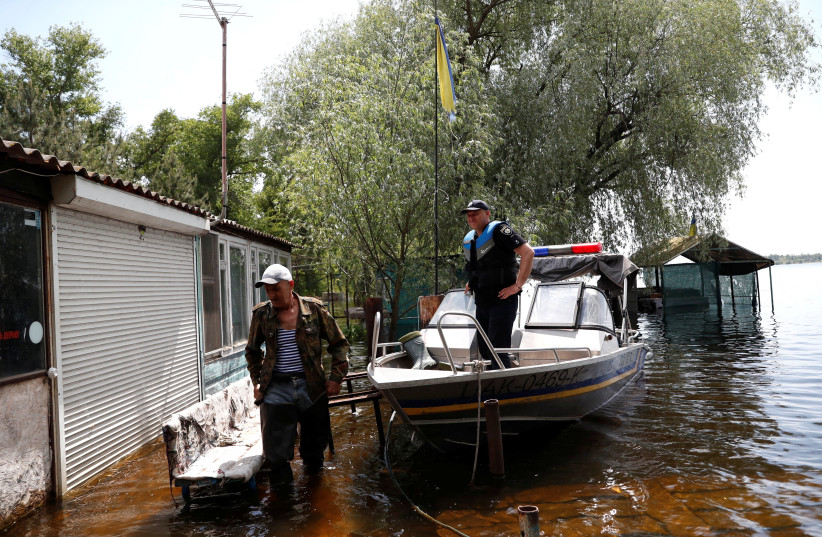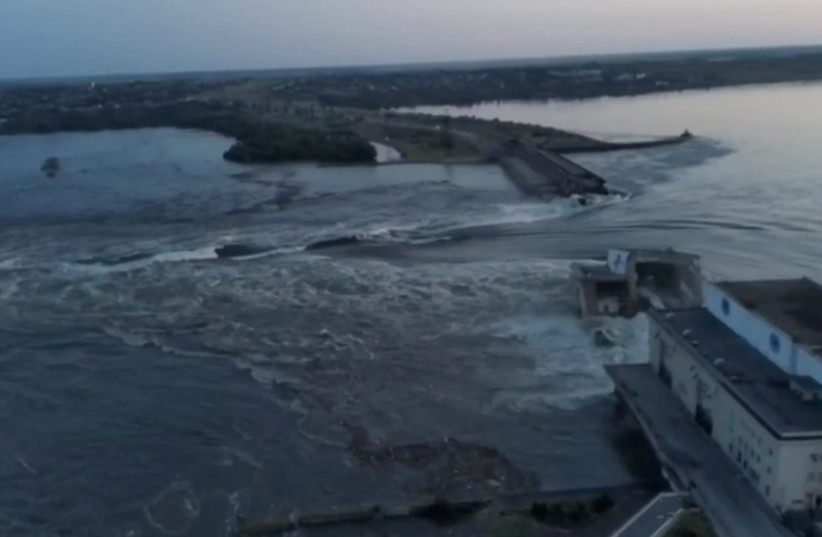by Reuters
What is the dam and what happened - and what do we not know?
 |
Mykola stands next to a police boat on a flooded
island, which locals and officials say is caused by Russia's chaotic
control of the Kakhovka dam downstream, amid Russia's attack on Ukraine,
near Zaporizhzhia, Ukraine, May 20, 2023.
(photo credit: BERNADETT SZABO / REUTERS)
|
A huge Soviet-era dam on the Dnipro River that separates Russian and Ukrainian forces in southern Ukraine was breached on Tuesday, unleashing floodwaters across the war zone. Ukraine said Russia had destroyed it, while Russian officials gave conflicting accounts, some saying it was destroyed by Ukrainian shelling and others saying it collapsed due to earlier damage.
What is the dam and what happened - and what do we not know?
The Kakhova dam
The dam, 30 meters (98 feet) tall and 3.2 km (2 miles) long, was built in 1956 on the Dnipro river as part of the Kakhovka hydroelectric power plant.
The reservoir also supplies water to the Crimean peninsula, which Russia claims to have annexed in 2014, and to the Zaporizhzhia nuclear plant, which is also under Russian control.
It holds an 18 km 3 reservoir - a volume about equal to the Great Salt Lake in the US state of Utah.

What happened at the dam?
Ukraine, which commented first, said Russia was responsible: "Russian terrorists. The destruction of the Kakhovka hydroelectric power plant dam only confirms for the whole world that they must be expelled from every corner of Ukrainian land," President Volodymyr Zelensky wrote on the Telegram messaging app.
"The Kakhovka (reservoir) was blown up by the Russian occupying forces," the South command of Ukraine's Armed Forces said. "The scale of the destruction, the speed and volumes of water, and the likely areas of inundation are being clarified."
Some Russian-installed officials blamed Ukraine:
The Russian-installed Kherson administration said Ukraine shelled the dam at around 2300 GMT, damaging the hydraulic valves.
"On Tuesday, June 6, the Ukrainian armed forces hit the Kakhovsky hydroelectric dam, as a result of which the upper part of the hydraulic structure was damaged," it said.
Other Russian-installed officials said no attack took place. Vladimir Rogov, a Russian-installed official in Zaporizhzhia, said the dam collapsed due to earlier damage and the pressure of the water. Russia's state news agency TASS carried a report to the same effect.
What is the human impact?
With water levels surging higher, many thousands of people are likely to be affected. Evacuations of civilians began on both sides of the front line.
22,000 people living across 14 settlements in Ukraine's southern Kherson region are at risk of flooding, Russian installed officials said. They told people to be ready to evacuate.
Ukrainian Prime Minister Denys Shmyhal said that up to 80 settlements were at risk of flooding.
The Russian-backed governor of Crimea said on Tuesday that there is a risk that water levels in the North Crimea Canal, which carries fresh water to the peninsula from the Dnipro river, could fall after the rupture of the dam.
The Crimean peninsula is dependent for fresh water on the canal. Ukraine previously blocked water supplies to Crimea after Russia annexed the peninsula in 2014, causing water shortages in the region.
Zaporizhzhia Nuclear Power Plant
The Zaporizhzhia Nuclear Power Plant, Europe's largest, gets its cooling water from the reservoir. It is located on the southern side, now under Russian control.
The UN nuclear watchdog, the International Atomic Energy Agency, said on Twitter it was closely monitoring the situation but that there was "no immediate nuclear safety risk at (the) plant".
Russia's state nuclear energy company Rosatom said on Tuesday there was no threat to the Moscow-controlled nuclear plant.
Reuters
Source: https://www.jpost.com/international/article-745367
No comments:
Post a Comment